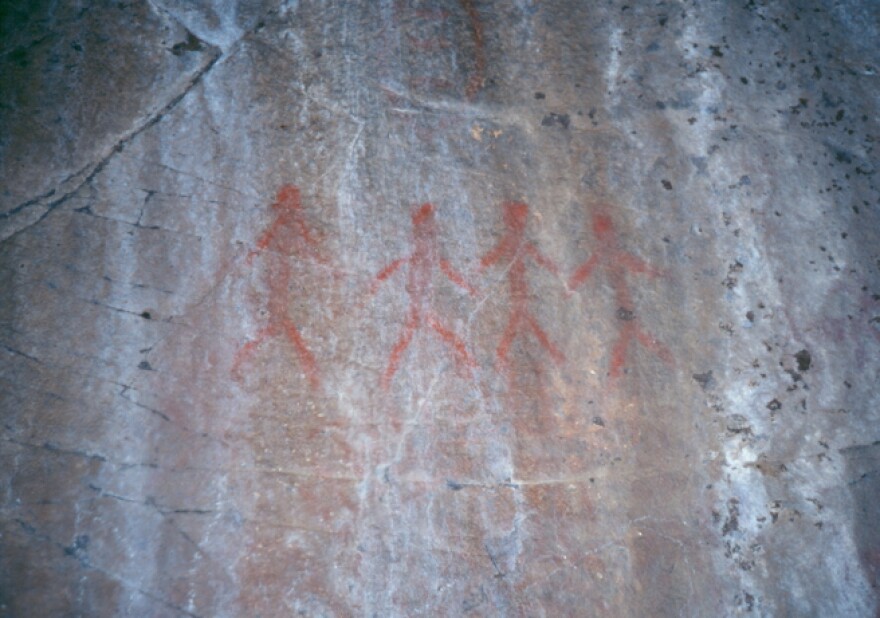Northwest history is colliding with the need to upgrade the region’s electric transmission grid. It’s happening on a windblown patch of riverfront property at the east end of the Columbia River Gorge.
The Bonneville Power Administration is trying to build a new transmission line across that land. But conflicts over historical preservation have increased the cost of the project to $185 million and stalled progress for more than a year.
More than 200 years ago Meriwether Lewis and William Clark portaged around the great and majestic Celilo Falls. Back then it was teaming with fish, and the tribes fished these waters for thousands of years.
This is where the Bonneville Power Administration proposes to cross the Columbia River with a new set of power lines. They’d carry electricity from colossal wind farms upriver to the I-5 corridor. A critical piece in this is a new 243-foot tower that would rise from a nearby bluff.
Robert Zornes hopes this won’t happen. He owns the property where the tower would go. “We view it as a watershed issue. If we can stop Bonneville, it will send the message that these cultural sites are worth protecting.”
Zornes and his wife bought their 122 acres in 2011. They thought it was the perfect spot to retire after 30 years of running an RV park on the Olympic Peninsula. Zornes acknowledges that there’s already a transmission tower along his bluff. But the tower BPA proposes is bigger and wider. “It’s the sheer mass and the size. It’s comparing a little buggy to a Hummer.”
Spurred by federal stimulus money, BPA has already done studies, gathered comments and begun construction elsewhere along the planned line. The agency satisfied concerns from conservation groups like the Friends of the Columbia Gorge.
It helped convince BPA to ditch an alternate route over a state park. Director Michael Lang says BPA also agreed to create a $1.8 million fund for projects to, for example, bury existing transmission lines elsewhere in the Gorge.
“In our analysis, the project was going to go forward,” explains Lang. “There really was no stopping it. It was a matter of reducing the impacts and then offsetting and mitigating for any impacts.”
But the project did stop more than a year ago and Zornes had a hand in it. Here’s what happened. Zornes invited a group from the Yakama Nation to a meeting on his property. He offered the delegation, led by a tribal leader named Johnson Menineck, full access to the historic grounds.
The work that followed by Yakama archeologists raised new concerns about a cave at the site. On a wall inside is an ancient painting of four human-like figures. Tribes consider it sacred and it’s very close to where BPA planned to blast holes for tower footings.

The Yakama Nation has filed a range of objections and are negotiating ways to protect the cave and the wider historical landscape.
For its part, the BPA says it’s committed to preserving culturally sensitive spots. Spokesman Doug Johnson says the agency agreed to a number of changes, including moving that tower 20 feet away from its original spot.
“We have partners that have concerns,” says Johnson. “And when that comes to our attention, we’re going to talk to them. And we’re going to work through the issues that they have and make sure that they’re consistent with our goal to bolster our transmission system and do it. But we want to make sure we do it right.”
But relations have been tense because elsewhere on the transmission project, a construction crew plowed over a tribal cairn. That’s a sacred memorial marker built of stone.
The BPA wrote a letter of apology and agreed to a $2 million fund to mitigate the affects of the transmission line on cultural sites. The incident outraged Allyson Brooks. She heads the Washington state office in charge of historic preservation. Brooks says complaints to BPA seem to drop into a “black hole.” But she says the issues raised here go well beyond this project.
“It’s the ongoing problem of trying to push through these energy project quickly at the same time protecting these cultural and natural resources,” says Brooks. “The balancing act isn’t there and it is a problem all over the western United States, not just Washington state.”
As for Robert Zornes, the BPA has a right away through his property. So a legal settlement with him is possible but not necessary. “I can’t stop them,” he says. “They can go through. Some people want to say I’m some sort of folk hero of some sort. It’s not me that’s stopping them. It’s the history that’s stopping them."
The latest dispute is whether the site is eligible as an official Lewis and Clark landmark. BPA says no, that the spot where the explorers portaged around Celilo Falls is likely now underwater because of The Dalles Dam.
That view is rejected by the National Park Service and Washington state. They argue that even with the dam, the railroad tracks, and the silencing of Celilo Falls, someone from 1805 would recognize the spot as largely intact. It’s one of several conflicts the BPA hopes to settle so construction on the new transmission line can resume again this fall.


